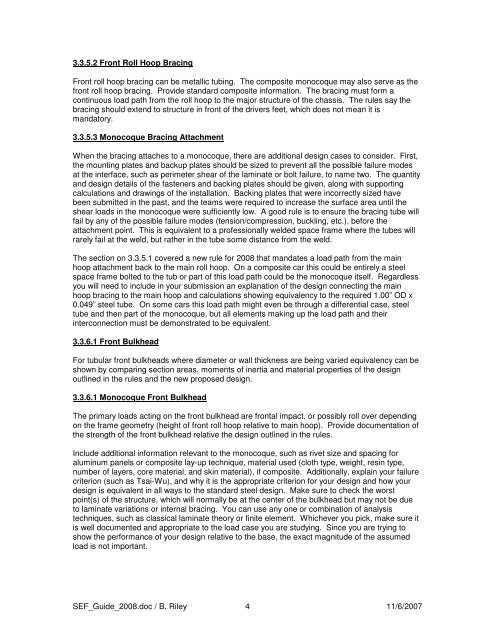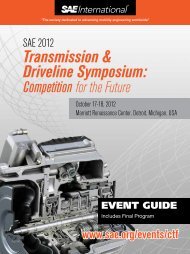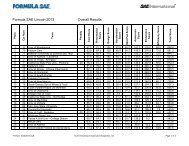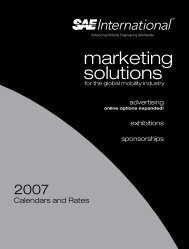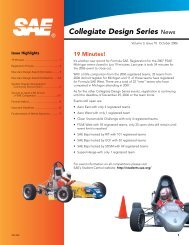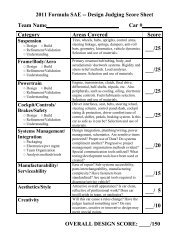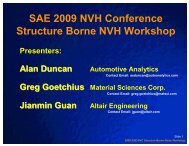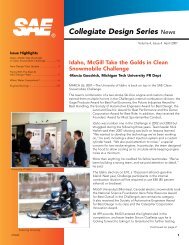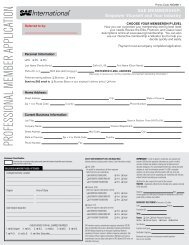Formula SAE A Guide to Meeting the Structure Equivalency ...
Formula SAE A Guide to Meeting the Structure Equivalency ...
Formula SAE A Guide to Meeting the Structure Equivalency ...
You also want an ePaper? Increase the reach of your titles
YUMPU automatically turns print PDFs into web optimized ePapers that Google loves.
3.3.5.2 Front Roll Hoop Bracing<br />
Front roll hoop bracing can be metallic tubing. The composite monocoque may also serve as <strong>the</strong><br />
front roll hoop bracing. Provide standard composite information. The bracing must form a<br />
continuous load path from <strong>the</strong> roll hoop <strong>to</strong> <strong>the</strong> major structure of <strong>the</strong> chassis. The rules say <strong>the</strong><br />
bracing should extend <strong>to</strong> structure in front of <strong>the</strong> drivers feet, which does not mean it is<br />
manda<strong>to</strong>ry.<br />
3.3.5.3 Monocoque Bracing Attachment<br />
When <strong>the</strong> bracing attaches <strong>to</strong> a monocoque, <strong>the</strong>re are additional design cases <strong>to</strong> consider. First,<br />
<strong>the</strong> mounting plates and backup plates should be sized <strong>to</strong> prevent all <strong>the</strong> possible failure modes<br />
at <strong>the</strong> interface, such as perimeter shear of <strong>the</strong> laminate or bolt failure, <strong>to</strong> name two. The quantity<br />
and design details of <strong>the</strong> fasteners and backing plates should be given, along with supporting<br />
calculations and drawings of <strong>the</strong> installation. Backing plates that were incorrectly sized have<br />
been submitted in <strong>the</strong> past, and <strong>the</strong> teams were required <strong>to</strong> increase <strong>the</strong> surface area until <strong>the</strong><br />
shear loads in <strong>the</strong> monocoque were sufficiently low. A good rule is <strong>to</strong> ensure <strong>the</strong> bracing tube will<br />
fail by any of <strong>the</strong> possible failure modes (tension/compression, buckling, etc.), before <strong>the</strong><br />
attachment point. This is equivalent <strong>to</strong> a professionally welded space frame where <strong>the</strong> tubes will<br />
rarely fail at <strong>the</strong> weld, but ra<strong>the</strong>r in <strong>the</strong> tube some distance from <strong>the</strong> weld.<br />
The section on 3.3.5.1 covered a new rule for 2008 that mandates a load path from <strong>the</strong> main<br />
hoop attachment back <strong>to</strong> <strong>the</strong> main roll hoop. On a composite car this could be entirely a steel<br />
space frame bolted <strong>to</strong> <strong>the</strong> tub or part of this load path could be <strong>the</strong> monocoque itself. Regardless<br />
you will need <strong>to</strong> include in your submission an explanation of <strong>the</strong> design connecting <strong>the</strong> main<br />
hoop bracing <strong>to</strong> <strong>the</strong> main hoop and calculations showing equivalency <strong>to</strong> <strong>the</strong> required 1.00” OD x<br />
0.049” steel tube. On some cars this load path might even be through a differential case, steel<br />
tube and <strong>the</strong>n part of <strong>the</strong> monocoque, but all elements making up <strong>the</strong> load path and <strong>the</strong>ir<br />
interconnection must be demonstrated <strong>to</strong> be equivalent.<br />
3.3.6.1 Front Bulkhead<br />
For tubular front bulkheads where diameter or wall thickness are being varied equivalency can be<br />
shown by comparing section areas, moments of inertia and material properties of <strong>the</strong> design<br />
outlined in <strong>the</strong> rules and <strong>the</strong> new proposed design.<br />
3.3.6.1 Monocoque Front Bulkhead<br />
The primary loads acting on <strong>the</strong> front bulkhead are frontal impact, or possibly roll over depending<br />
on <strong>the</strong> frame geometry (height of front roll hoop relative <strong>to</strong> main hoop). Provide documentation of<br />
<strong>the</strong> strength of <strong>the</strong> front bulkhead relative <strong>the</strong> design outlined in <strong>the</strong> rules.<br />
Include additional information relevant <strong>to</strong> <strong>the</strong> monocoque, such as rivet size and spacing for<br />
aluminum panels or composite lay-up technique, material used (cloth type, weight, resin type,<br />
number of layers, core material, and skin material), if composite. Additionally, explain your failure<br />
criterion (such as Tsai-Wu), and why it is <strong>the</strong> appropriate criterion for your design and how your<br />
design is equivalent in all ways <strong>to</strong> <strong>the</strong> standard steel design. Make sure <strong>to</strong> check <strong>the</strong> worst<br />
point(s) of <strong>the</strong> structure, which will normally be at <strong>the</strong> center of <strong>the</strong> bulkhead but may not be due<br />
<strong>to</strong> laminate variations or internal bracing. You can use any one or combination of analysis<br />
techniques, such as classical laminate <strong>the</strong>ory or finite element. Whichever you pick, make sure it<br />
is well documented and appropriate <strong>to</strong> <strong>the</strong> load case you are studying. Since you are trying <strong>to</strong><br />
show <strong>the</strong> performance of your design relative <strong>to</strong> <strong>the</strong> base, <strong>the</strong> exact magnitude of <strong>the</strong> assumed<br />
load is not important.<br />
SEF_<strong>Guide</strong>_2008.doc / B. Riley 4 11/6/2007


